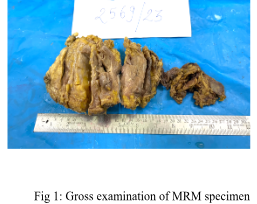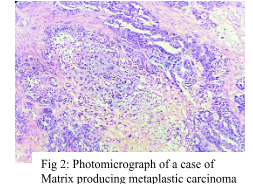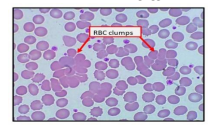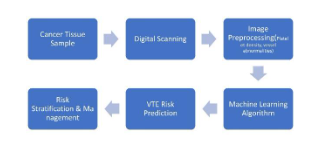Metaplastic Carcinoma of Breast – An Old Histotype with New Diagnostic Challenges: Experience Of an Oncology Referral Centre
Dr. Ekaparna Hazarika

Keywords: Metaplastic carcinoma, Breast cancer, Triple negative breast cancer
Dr. Ekaparna Hazarika (Presenting author) 1 and Dr. Muktanjalee Deka 2
1 Fellowship in Oncopathology, State Cancer Institute, Gauhati Medical College & Hospital (Mailing address: Pragjyotis Apartment B1B, Ananda nagar bylane-3, Opposite Anil plaza, GS road, Guwahati-781005, Assam, India. Institute name: State Cancer Institute, Gauhati Medical College & Hospital),
2 Professor and Head of Department, Department of Oncopathology, State Cancer Institute, Gauhati Medical College & Hospital (Mailing address: House no. 1, Shanti Path, Tangra Satra road, Rukminigaon, Guwahati-781022. Institute name: State Cancer Institute, Gauhati Medical College & Hospital).
Background: Metaplastic carcinoma of breast are rare heterogenous group of tumors characterized by differentiation of neoplastic glandular epithelium into squamous and/or mesenchymal-like elements. Given the large variety of morphological mimics and intra-tumoral heterogeneity, the histopathological diagnosis andcategorization is challenging and important because of the treatment and outcome of the disease.In this series, we aim to study the clinicopathological features of Metaplastic carcinoma of breast and highlight the diagnostic challenges.
Materials and Results: This case series is a compilation of trucut biopsies and surgically resected specimens of 14 patients, who presented with median age of 49.5 years and high-density lesions with irregular margins on Sono-mammography. On histopathological examination we encountered monophasic and biphasic tumors comprising of squamous type, spindle cell type and matrix producing components. To render a diagnosis of pure squamous type Metaplastic carcinoma, careful elimination of primary Squamous carcinoma elsewhere had to be done following meticulous clinical history and examination. Another case was Metaplastic carcinoma with a low-grade spindle cell component resembling fibromatosis, which had to be distinguished from the wide array of spindle cell lesions of breast most importantly, scars and Phyllodes’ tumor. Immunohistochemistry was particularly useful in this case, owing to Cytokeratin positivity. There was a case of Matrix producing Metaplastic carcinoma, wherein the presence of heterologous elements had to be checked to rule out Malignant Phyllodes’ tumor. This case was diagnosed as Invasive duct carcinoma of No special type and triple negative subtype on trucut biopsy. So, we had to do generous sampling before arriving at a diagnosis.
Conclusion: Although, majority of the histological subtypes are aggressive and high grade, identification of low-risk histology is important, especially the newly added entities because these carry a favorable outcome. Recent studies on molecular and genetic profiles have provided a better understanding of the tumor and will eventually aid in overcoming the diagnostic pitfalls and further prognostication.



References:
[1] The WHO Classification of tumours editorial board (Ed.). (2019). WHO Classification of breast tumours 5th edition.
[2] Syed A. Hoda, Edi Brogi, Frederick C. Koerner, Paul P. Rosen. Rosen’s breast pathology 4th edition.
[3] Rungta, S., & Kleer, C. G. (2012). Metaplastic carcinomas of the breast: Diagnostic challenges and new translational insights. Archives of Pathology & Laboratory Medicine, 136(8), 896–900.
[4] Işil Günhan-Bilgen. Ayşenur Memiş, Esin Emin Üstün. Metaplastic Carcinoma of the Breast: Clinical, Mammographic, and Sonographic Findings with Histopathologic Correlation.
[5] Alhaidary, A. A., Arabi, H., Elessawy, M., & Alkushi, A. (2022). Metaplastic breast carcinoma: an overview of the radio-pathologic features in retrospective cohort tertiary hospital. The Egyptian Journal of Radiology and Nuclear Medicine, 53(1).
[6] Yang, E., Fineberg, S., Mohamed, A., Brogi, E., & Wen, H. (2024). Variability in the diagnosis and reporting of metaplastic breast carcinoma: results of an international survey. Histopathology.
[7] Zhao, Y., Gong, X., Li, N., Zhu, B., Yu, D., & Jin, X. (2018). Fibromatosis-like metaplastic carcinoma of breast: a challenge for clinicopathologic diagnosis. International Journal of Clinical and Experimental Pathology, 11(7), 3691–3696.
[8] McMullen, E. R., Zoumberos, N. A., & Kleer, C. G. (2019). Metaplastic breast carcinoma: Update on histopathology and molecular alterations. Archives of Pathology & Laboratory Medicine, 143(12), 1492–1496.
[9] Metaplastic Breast Cancer: Current Understanding and Future Directions Thomas, Alexandra et al. Clinical Breast Cancer, 23, 775–783.
[10] Deniz Eren Böler a, Halil Kara a, Yeşim Sağlıcan b, Fatma Tokat b, Cihan Uras a, Department of General Surgery. Metaplastic carcinoma of the breast: A case series and review of the literature
Biography: Dr. Ekaparna Hazarika has completed her MBBS in the year 2017, following which she pursued her MD in Pathology in Gauhati Medical College and Hospital, Assam, India, in the year 2023. She is currently pursuing her Fellowship in Oncopathology at State Cancer Institute, Assam, India. Her areas of interest are Oncopathology, Head and Neck oncology, Breast pathology and Lymphoma.
Presenting author details:
Full Name: Dr. Ekaparna Hazarika
Category: Poster presentation
Track name: Breast Pathology (Track 4)
Research interest: Oncopathology, Head and Neck Oncology, Breast pathology and Lymphoma.
#UCJournals #DigitalPathology #CancerResearch #PathologyInnovation #AIinPathology #DigitalHealth #CancerDiagnostics #PrecisionMedicine #PathologyResearch #MedicalImaging #OncologyResearch #CancerDetection #PathologyLab #DigitalOncology #AIinHealthcare #Histopathology #MedicalResearch #CancerAwareness #PathologyInnovation #DigitalDiagnostics #CancerCare #MedicalTechnology #HealthcareInnovation #CancerTreatment #PathologyTech #AIPathology #TumorAnalysis #CancerBiology #MedicalAI #PathologyEducation #CancerStudies #ClinicalPathology #DigitalMedicine #OncologyInnovation #CancerBiomarkers #PathologyCommunity #DigitalHistology #SmartPathology #CancerScience #PathologyUpdates #MedicalPathology #PrecisionOncology #CancerTherapy #DigitalLab #PathologyDigital #OncologyDiagnostics #AIOncology #CancerScreening #MedicalInnovation #PathologyTrends #DigitalHealthcare #FutureOfPathology
Upcoming Conferences;
- 16th Emirates Pathology, Digital Pathology & Cancer Conference
More Details: https://pathology.utilitarianconferences.com/
- Submit your abstract/research papers/case- study here: https://pathology.utilitarianconferences.com/submit-abstract
- Attend as a Speaker/Poster/Delegate In-person kindly register here: https://pathology.utilitarianconferences.com/registration
- Attend as a Speaker/Poster/Delegate virtually kindly register here: https://pathology.utilitarianconferences.com/virtual-registration



